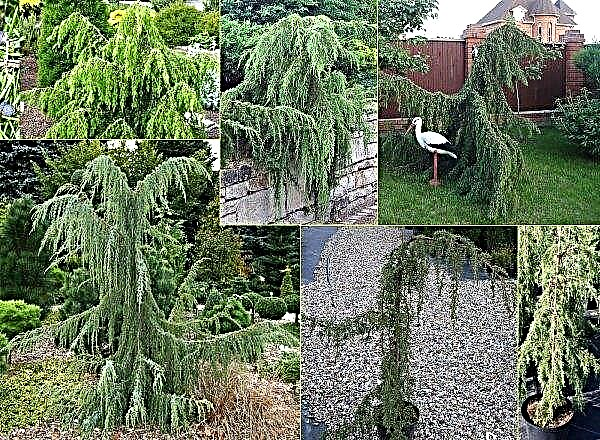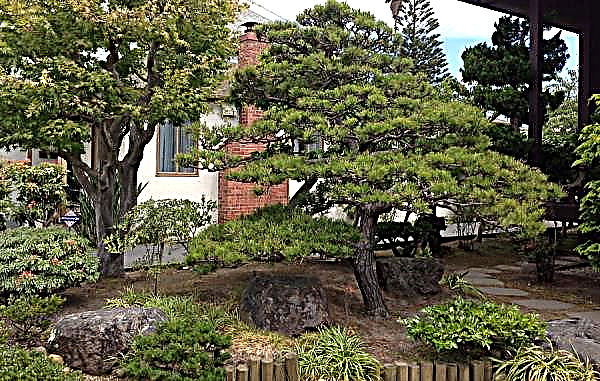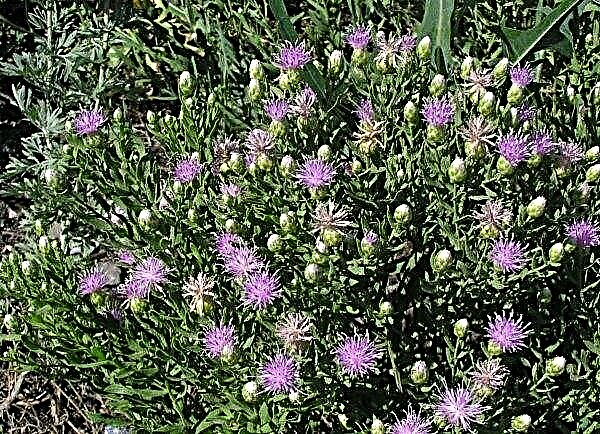The Chinese style of landscape design is a combination of nature and elegance. It includes a significant part of China's 5,000-year-old horticultural culture, including several dynastic traditions. The creation of such a garden on the site is not only an exciting lesson, but also a demonstration of the designer and horticultural talent of the owners.
Chinese style features
Several dynastic periods have influenced Chinese gardening and the particularities of creating gardens. Each of them added new views, expanding the set of basic elements. Initially, they were conceived as a habitat - a "house" for animals used for hunting and resting the emperor. The earliest were created in the Yellow River valley during the Shang Dynasty (1600-1046 BC). They were large enclosed parks where emperors and aristocracy hunted game or where fruits and vegetables were grown. The imperial garden was designed to demonstrate greatness and grandeur.
Did you know? In ancient Chinese sources there is no clear definition of the concept of a garden. It is believed that the hieroglyph by which it is indicated should be interpreted as a combination of “water, land, leaves and fences”.
The gardens of the Qin Dynasty (221–206 AD) were decorated with palaces and pavilions. They were complemented by magnificent plants and flowers, planted in moderation. The Wei Dynasty (220–265) added more elements of nature, in particular mountains and rivers. Their design was called "Garden with natural mountains and rivers." The contribution of the Sui (581–618) and Tang (618–907) dynasties to classical gardening was to bring in aspects of art and literature. It is to this period that the development of the scientist’s garden and other areas belongs. Emperor Kangxi of the Ming Dynasty (1386–1644) paid a lot of attention to garden buildings that had an exclusively decorative purpose.
The border of a typical Chinese garden is limited by walls, inside of which there are:
- several ponds;
- stone compositions;
- trees;
- flowers
- halls and pavilions.
All this is connected by winding paths and galleries. Moving around the territory, the visitor, as it were, reads the main idea conveyed through various landscape scenes.

Views of Chinese gardens
The modern Chinese garden is an opportunity to create a small cozy world right in the backyard of your home. If the Western style emphasizes control over nature, then the Chinese demonstrates a person's ability to fit nature into an artificial landscape. It is created from simple elements that together form one common composition.
Now Chinese gardens are classified as follows:
- imperial hunting park;
- temple;
- scientist's garden (private);
- cemetery;
- natural (Resort park);
- back patio.

In general, the confusion in articles on landscape design arises from the combination of elements that, by their purpose, belong to one type, but are used by the designer in another. So, the royal gardens are more consistent with the term "landscape", combining hills and water. The scientist’s garden, that is, private, created as a place of relaxation and solitude for a scientist seeking to avoid the bustle of the city, began to develop actively since the Han Dynasty. The first documented garden of this type belonged to the calligrapher Wang Shizhi.
Did you know? The pagoda, according to Chinese beliefs, is known as the "place of peace." The high pointed tip at the top of its roof symbolizes a closer path to heaven and nirvana.
The Chinese courtyard, as a closed space, is also not a single object. At its core is a rectangular courtyard attached to the living room. Even in the Neolithic era, the dwelling was facing south, and the settlements were located on the north-south axis. The art of orienting buildings over time has become the basis of Feng Shui. The courtyards were surrounded by buildings, like the Romans, their outer walls had no windows, and the rich people had several courtyards, each of which had its own purpose. And everyone strictly followed the principles of geometric orientation.

Sacred temple gardens were a product of Taoism and Confucianism. They began to consider space as an element of cosmogony. The garden was supposed to help meditation and facilitate the transition of man to a more perfect state. In such places, ideal landscapes were created, combining geometry and naturalness.
Stages of creating a Chinese garden
Creating a garden is quite simple. First, select a place for it. Clean the area of weeds and vegetation that is not needed in your project. Now take paper and pencil and make a plan.
The garden should be compact, but include the main elements:
- A water body is mandatory, which can be a pond or stream. It is often the center of the territory. But often the building is also located near the reservoir, and then it becomes the center of the structure.
- The Chinese are sure to plant a small bamboo plantation, but carefully select its grade. Bamboo can be an invasive plant, which is not very good for a small garden.
- Now you need to pick up plants that will symbolize every season. So, bamboo symbolizes summer, chrysanthemum - autumn, plum - winter, and orchid - spring.
- Add artificial elements to the garden - mountain, hill, pavilion, bridge.
- Private courtyard is surrounded by walls, therefore, it is possible to provide elements that perform this function.

Site selection and preparation
In country houses, most often create a courtyard or garden scientist. In the first case, the concept of the courtyard is thought out and its center will be what it is used for. For example, a swimming pool or a green lawn, if it is a recreation area.
If we are talking about the scientist’s garden, then the garden and the house should be a single whole. Ideally, he should surround the house from all sides. Then in the south there will be a lawn with a quiet winding stream, it will bring positive energy (qi), fame and wealth. To the north of it should be a hill - a hill, a mountain. Nourishing energy will be gathered here, which gives a person strength. In the east are small hills that grant wisdom. A small pond in the west will deter aggressive destructive energy.
 The garden in front of the house is spacious and bright. It is open to the public and is an exit to the outside world. And the one behind the house is a personal space - it is more shady and thought-provoking.
The garden in front of the house is spacious and bright. It is open to the public and is an exit to the outside world. And the one behind the house is a personal space - it is more shady and thought-provoking.
The entrance is made out with a small gate through which a person passes into the world of spirituality, and a small arbor will become the center. It will personify the presence of man, as an element that exists in nature and at the same time harmoniously transforms it.
Traditional elements
The central space can combine several different parts, with contrasting elements describing the acts of the elements or be a three-dimensional picture, parts of which appear gradually, as you move through the territory. Elements of the transition will be walls, hedges, bridges, corridors, alleys.
The western form of the garden is a rectangle. Chinese - circle, square or octagon. It can also be a circle in which there are octagonal compositions. All five elements must be present in the garden.Important! Any element of the garden that has the shape of a bean grain or a geometrically irregular shape is considered bad feng shui and is subject to alteration.

Usually this:
- a pond, stream, another reservoir - water;
- sundial, bronze statue - metal;
- trees, shrubs - a tree;
- red and orange shades - fire;
- garden land represents the element of earth.
Fencing, gates, garden windows
Regardless of which gates and fences you prefer, they must meet the general concept. The classic fence of the Chinese garden is white walls. This shade was chosen so that the wall was the background, and did not distract attention from the most basic in the composition. The gate marks the starting point of the route from which visitors advance into the garden. They do not have to be big. Gates can only be marked with side posts or have a gate.
Original look bamboo fencing. They can not only divide the garden space, but also decorate the existing unsightly walls of farm buildings. This gives the structures a more well-groomed appearance.

Previously, the windows were located in accordance with the requirements of social etiquette - along one side of the site or around the central zone. Their functional task was very simple - to present a viewpoint to the viewer. The windows centered around the center make it possible to see a specific scene and this allows you to divide the garden into conceptual areas when creating the design.
And when a guest thinks that he has already seen everything, he has the opportunity to look through another window and discover something new. Those windows that were located on the outer wall should have given the opportunity to "see and be surprised."
 The moon gate is a round hole in the wall, which is a transition from one part of the garden to another. They can be built of stone or brick, and also be part of the wall.
The moon gate is a round hole in the wall, which is a transition from one part of the garden to another. They can be built of stone or brick, and also be part of the wall.
Ponds and Bridges
Water occupies an important place in the garden. It symbolizes life and is necessary to represent nature as a whole. In some places, stone must come into contact with water. They are opposite elements - yin and yang and at the same time symbolize the unity of the whole, creating harmony. And if you have a pond, then you need to make sure that it is convenient. So, its edges are sure to be lifted so that it is comfortable to sit with your feet in the water. If you run fish in it, then from the point of view of Feng Shui, they will attract wealth. Several dams, in which water flows from one to another, will also be a good solution.
Important! Be sure to take care of the water purification system, otherwise pollution will violate its natural ecosystem.
Water expands the spatial concept. The surface of the reservoir, reflecting objects makes the garden visually larger. And with the help of dams, bridges, islands and other auxiliary structures, the surface is divided into scenes of various shapes.

Running water makes various sounds - the cheerful noise of a stream, the rumble of a waterfall. Sounds can cause a person to various emotional states. By combining water and stones, the designer produces sounds just like a musician melody.
Pavilions and gazebos
Ideally, buildings and structures should complement the situation, and not dominate it. The types of buildings that are included in the garden are related to its owner. For example, a scientist may have a library pavilion, and an athlete may have a gym pavilion. Some buildings are interconnected by corridors, galleries, bridges.
The classic garden includes:
- Ceremonial hall - A room used for family celebrations, receptions, for banquets and for celebrations. Such a room is built with a veranda or terrace to provide guests with outdoor recreation.
- Flower Pavilion - a room next to the main hall, filled with flowers or with a small rock garden.
- Room of four doors - a building with folding walls that offers panoramic views of the garden.
- Mandarin Duck Pavilion. This is a building that consists of two visually different parts. One of them faces north and is used in summer, and the other to the south. The first is a shelter from the heat on a sunny day, and the second, on the contrary, should cause a feeling of internal warmth on a winter day. It is convenient here to watch the dawn or how the moonlight glides over the surface of the pond.
- Some gardens have scenic water pavilions. They can be either fully decorative or functional, used for a tea ceremony.
Stone lions, bonsacks, lanterns
Artificial mountains or rock gardens are an integral part of the garden. The mountain peak is considered a symbol of virtue, stability, endurance. A mountain on an island in the middle of a body of water is part of the legend of the islands of the Immortals. Therefore, this symbol is most often used in Chinese gardens. The composition of the stones should reflect the ideal location of the house - steep mountains in the north and smooth hills in the south. They should be carefully planned, and not just fit into the landscape stones remaining after the construction of the pond or wall.
Did you know? It is believed that for the first time lions came to China during the Han Dynasty (206 BC. — 220 year n.
Buddhism has been an integral part of Chinese garden design for hundreds of years. His main idea is the path to enlightenment or paradise. And if paradise is represented by the mountain of the Immortals, then a road should lead to it. The Chinese built rock gardens, laying next to them gravel paths leading to enlightenment. The paths were often decorated with lanterns, and along them one could meet Buddha statues.
 Traditionally, the deity's gaze is directed to the north, and serenity reigns around. The Buddha is often depicted on a lotus flower, so it is appropriate to place the statue next to the pond.
Traditionally, the deity's gaze is directed to the north, and serenity reigns around. The Buddha is often depicted on a lotus flower, so it is appropriate to place the statue next to the pond.
Stone lion is a common element of Chinese architecture. He is a symbol of security and good luck. Therefore, lion statues can be found everywhere - in the imperial palace, temple, Buddha pagoda, on the bridge, in the garden and in the private courtyard. Paired lions are placed symmetrically in front of the entrance to the building. The male is set on the left, and the female on the right.
The image of a lion in each of the dynastic periods is different. Han and Tang are strong and powerful, while Yuan are thinner but equally strong. The most delicate and meek sculptures of lions belong to the Ming and Qing dynasties.
Literally, bonsaki means "tray-stone." This is a temporary structure that is created for a wedding, new year celebration or other ceremony. It is made up of natural stone and other elements: bird feathers, sand, gravel. It is placed on a special table. It depicts part of the landscape, the sea, mountains and other natural objects.

Lanterns in China symbolize vitality, social status and good fortune. Around the world, the round red light remains one of the most recognizable trademarks of Chinese culture. Its frame is made of metal wire or bamboo strips, covered with paper, silk or thin gauze, and then painted in one color or another. Red is associated with joy and luck. Such lanterns adorn any holiday or ceremony.
Did you know? The yellow emperor was the mythical founder of China. Therefore yellow — color of imperial mantles.
Colors
Every nation has a certain meaning attached to flowers. According to the theory of 5 elements, there are 5 primary colors: red; yellow; blue; White and black.
- Red is the color of joy, celebration, happiness. It symbolizes the element of fire. Of great importance to the Chinese is the organization of proper energy circulation. And if it stagnates in some place, it is recommended to place an element of red color there.
- Blue most often has a negative value. It is associated with water, in winter and in the north. The use of blue shades in design is considered unfortunate.
- Yellow seems very favorable. It correlates with the earth and the center.
- White is essentially the lack of color. It is not connected with the cardinal points and in China means death. Therefore, white in the garden is painted only with those elements that should be visually invisible, such as walls.
- Black is the color of destruction. It signifies darkness, chaos, and is rarely used in landscape design.

Arrangement of tracks
The path leading to the house is the most important. It should smoothly bend, leading guests to the house in a good mood and good health. On a very straight path, guests will walk too fast and feel restless. If she begins to wriggle too much, it will tire them. Tracks should be paved with solid elements: stone, colored pebbles, curly tiles.
Garden furniture
When designing a garden, determine which sector to place the seats in. It is advisable to place them in your area of social activity. Being in the relationship sector, they will help you relax, rest and recharge your batteries. As for its shape, the seat should have a backrest from straight bars - it activates the movement of qi. Forged iron stools, on the contrary, will slow down the flow of energy and contribute to thought.

What plants are used for decoration
Flowers and trees are an equally important component of the garden, which is one of the four main ones. They represent nature in its most striking form and contrast with the straight lines of architecture and the constancy and stillness of the stones. There will be no lawns in the Chinese garden, as in English. Here the plants are in an environment close to natural.
Important! It is advisable to place arches twined with plants along the garden path. But roses with thorns cannot be planted. Spikes can damage guests, so roses along the central mall are considered bad feng shui.
Plants are constantly changing their appearance, depending on the season. Each flower or tree has an additional meaning in the garden composition. In the classical gardens of ancient China, pine, bamboo and Chinese plum were valued because they remained elegant and green even in winter. Bamboo, a hollow straw, represented a wise man, humble and seeking knowledge.

He was known for not breaking during a storm. Plums were revered as a symbol of rebirth after winter and the arrival of spring. The peach tree symbolized longevity and immortality. Pears were a symbol of justice and wisdom. Apricot symbolized the official and his life path. Willow - friendship and joy of life. Of the flowers, lotus and orchid were valued.
Plants are recommended to be selected very carefully, evaluating their appearance, color, shape and aroma. The Chinese often plant lotus in the pond, and choosing other flowers are guided exclusively by their aroma.
Commonly used plants:
- Manchu apricot (Prunus mandshurica);
- flowering almonds (Prunus triloba);
- bamboo (Phyllostachys spp.);
- Peking cotoneaster (Cotoneaster acutifolius);
- Chinese lilac (Syringa x chinensis);
- sacred lotus (Nelumbo nucifera);
- Chinese vine (Lycium chinense);
- Chinese pear (Prunus ussuriensis);
- Spirea (Spiraea thunbergii);
- Eastern thuja (Thuja orientalis).
The Chinese garden is a peculiar phenomenon of Chinese culture, reflecting the traditions of garden design present in the country. It also reflects the interaction of man and nature. Start creating a garden by understanding the idea and making a plan on paper. Remember that it not only reflects the enthusiasm for the culture of China, but also should be a place of relaxation and restoration of harmony with the outside world for you, your family members and friends.












